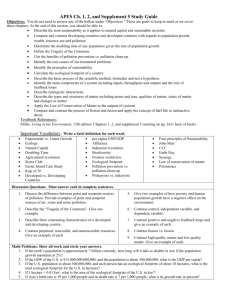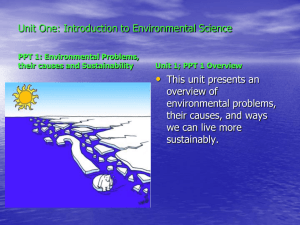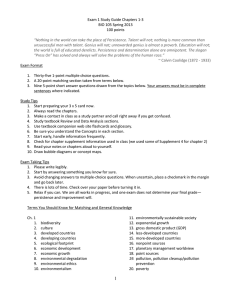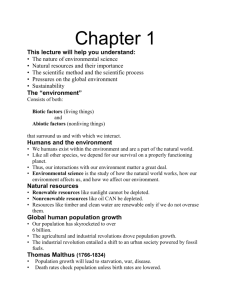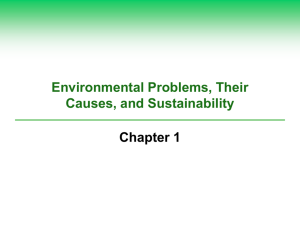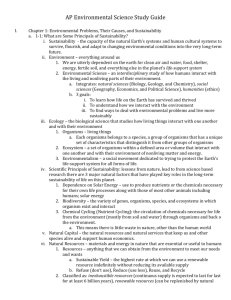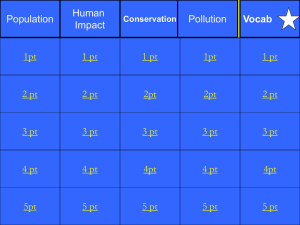Chapter 1 Powerpoint
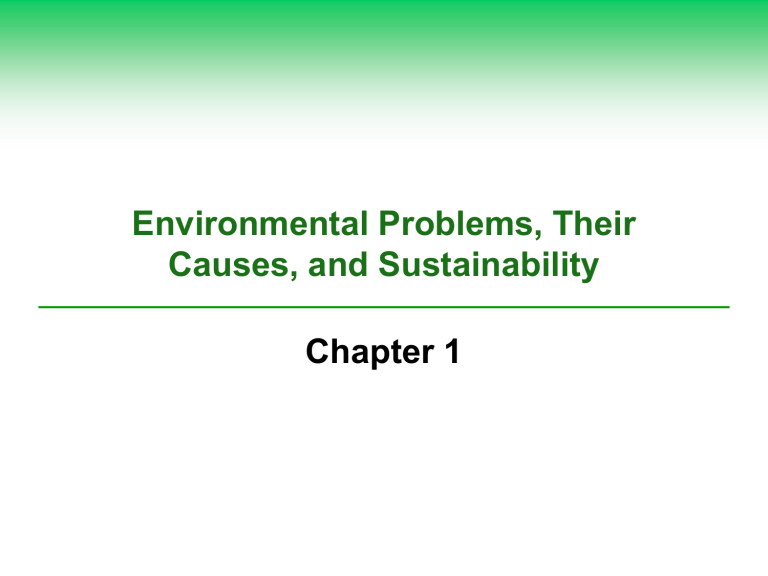
Environmental Problems, Their
Causes, and Sustainability
Chapter 1
Core Case Study: Living in an
Exponential Age
Exponential Growth: quantity increases at a fixed rate per unit of time.
$10 per hour or $.01 doubled for 30 days?
Starts slowly but after only a few doubles grows to enormous sizes.
Impact of human exponential growth on
• Loss of animal and plant species
• Loss of resources
Exponential growth has caused:
More people means more land use to stay alive
(The poor must deplete to compete)
Increasing Human ecological footprint causes loss of habitats and biodiversity.
Exponentially growing human activity will play a significant role in earth’s changing climate.
Country Y has 150,000 people in it. 27% of these people are malnourished and at risk of death from starvation and malnourishment. How many people in this country are at risk?
2 –5 million years
8000
Hunting and gathering
6000
?
Industrial revolution
Black Death —the Plague
4000
Time
2000
B. C.
A. D.
2000 2100
0
3
2
1
5
4
13
12
7
6
11
10
9
8
Agricultural revolution Industrial revolution
Fig. 1-1, p. 5
6
7
8
3
4
5
1 1830
50,000 years
2
100
Billions by year
1960
1975
1989
30 years
15 years
14 years
1999
2011
2025
10 years
12 years
14 years
The recent rate of increase has slowed due to diminishing birth rates.
9 2045
20 years
.
What could intervene?
1. Starvation - Can the world feed 8 billion people? Some say no.
2. Disease Epidemic
3. Nuclear winter - nuclear war, comet, or asteroid
4. Birth rate change
5. The Earth's poles flip
6. The Apocalypse
Rule of 70
70 / % growth = doubling time
1% - U.S. 3% - Ethiopia 5% - ?
1-1 What Is an Environmentally
Sustainable Society?
Concept 1-1A Our lives and economies depend on energy from the sun (solar capital) and on natural resources and natural services
(natural capital) provided by the earth.
Concept 1-1B Living sustainability means living off the earth’s natural income without depleting or degrading the natural capital that supplies it.
Environmental Science Is a Study of
Connections in Nature (1)
Interdisciplinary science connecting information and ideas from
• Natural sciences, with an emphasis on ecology
• Social sciences
• Humanities
Environmental Science Is a Study of
Connections in Nature (2)
How nature works
How the environment affects us
How we affect the environment
How to deal with environmental problems
How to live more sustainably
Major Fields of Study Related to
Environmental Science
Political science
Philosophy
Ethics
Biology
Ecology
Economics
Chemistry
Demography
Anthropology
Geography
Geology
Physics
Fig. 1-2, p. 7
Sustainability
Ability of earth’s systems, including human cultural systems and economies, to survive and adapt to changing environmental conditions, indefinitely.
Sustainability Is the Central Theme of
This Book
1. Natural capital: supported by solar capital
• Natural resources
• Natural services
• E.g., nutrient cycling
•
2.
Solar capital: energy from sun
Warms planet
• Supports photosynthesis
• Produces indirect forms of renewable energy
Scientific solutions
Degrading natural capital
* Degradation of natural capital through human activities
Rate caused by humans much faster than natural rates of change.
NATURAL
CAPITAL
Natural Capital = Natural Resources + Natural Services
Solar capital
Air
Air purification
Climate control
UV protection
(ozone layer)
Water
Water purification
Waste treatment
Nonrenewable minerals iron, sand)
Oil
Soil
Renewable energy
(sun, wind, water flows)
Soil renewal
Land
Food production
Pest control
Nutrient recycling
Life
(biodiversity)
Population control
Nonrenewable energy
(fossil fuels)
Natural resources
Natural services
Environmentally Sustainable Societies
Protect Natural Capital and Live off Its Income
Live off natural income
Human activity and its affect on the earth’s natural capital
Important lesson is “Protect our capital and live off the income it provides”
We are wasting, depleting, and degrading earth’s natural capital at exponential rates.
1-2 How Can Environmentally Sustainable
Societies Grow Economically?
Concept 1-2 Societies can become more environmentally sustainable through economic development dedicated to improving the quality of life for everyone without degrading the earth's life support systems.
There Is a Wide Economic Gap between
Rich and Poor Countries
Economic growth: increase in capacity of a country to provide good and services.
Country’s economic growth: measured by gross domestic product (GDP) – annual market value of all goods and services
Changes in economic growth: measured by per capita GDP (midyear: GDP / total population)
Purchasing power parity (PPP) plus GDP are combined for per capita GDP PPP
Compare developed with developing countries
Top 10 GDPs
United States
2 China
3 India
Japan
Germany
6 Russia
Brazil
United Kingdom
9 France
10 Italy
Economic developed vs. developing
Developed (1.2 billion) – highly industrialized and have high per capita GDPs. (U.S. , Canada,
Japan, Australia, New Zealand, most European countries
Developing (5.4 billion) – most in Africa, Asia, and Latin America. Some of these are moderately developed, middle income (China,
India, Brazil, Mexico) Others are low income.
Percentage of
World's:
Population
18%
Population growth
0.12%
1.46%
Life expectancy
Wealth and income 15%
Resource use
12%
Pollution and waste 25%
Developed countries
82%
77 years
67 years
85%
75%
Developing countries
88%
Fig. 1-5, p. 11
Extreme Poverty in a Developing Country
1-3 How Are Our Ecological Footprints
Affecting the Earth?
Concept 1-3 As our ecological footprints grow, we are depleting and degrading more of the earth’s natural capital.
Some Sources Are Renewable (1)
Resource: anything obtained from the environment to meet our needs and wants.
Examples include food, water, shelter, metals
• Solar energy, fresh air, wind, fresh surface water, fertile soil, and wild, edible plants are directly available for use.
• Petroleum, iron, groundwater, modern crops are not directly available for use
Perpetual resource
• Solar energy
Some Sources Are Renewable (2)
Renewable resource: on human time scale, can be replenished rapidly.
• E.g., forests, grasslands, fresh air and water, fertile soil
Sustainable yield – highest rate at which a renewable resource can be used indefinitely without reducing its available supply.
Environmental degradation – occurs when we exceed a resources natural replacement rate
Degradation of Normally Renewable
Natural Resources and Services
Overexploiting Shared Renewable
Resources: Tragedy of the Commons
Three types of property or resource rights
• Private property – we protect our investment
• Common propertywe don’t care as much
• Open access renewable resources
Tragedy of the commons – Garrett Hardin
• Solutions
• 1. Use free-access resources at rates below their estimated sustainable yields.
• 2. Convert free-access resources to private ownership.
Some Resources Are Not Renewable
Nonrenewable resources – exist in a fixed quantiy.
• Energy resources (coal, oil, natural gas)
• Metallic mineral resources
• Nonmetallic mineral resources
• Economic Depletion occurs?
Reuse
Recycle
Reuse
Consumption of Natural Resources
Consumption of Natural Resources
Our Ecological Footprints Are Growing
Ecological footprint concept
• Biological capacity
• Ecological footprint
• Force of our footprint also a concern
• 1. Agriculture
• 2. transportation
• 3. heating and cooling buildings
Total Ecological Footprint (million hectares) and Share of Global Ecological Capacity (%)
United States
European Union
China
India
Japan
Per Capita Ecological Footprint
(hectares per person)
780 (7%)
540 (5%)
2,810 (25%)
2,160 (19%)
United States
European Union
2,050 (18%) China
India
Japan
0.8
1.6
4.7
4.8
9.7
Projected footprint
Earth's ecological capacity
Ecological footprint
Fig. 1-10, p. 15
Total Ecological Footprint (million hectares) and Share of Global Ecological Capacity (%)
United States
European Union
China
India
Japan
Per Capita Ecological Footprint
(hectares per person)
780 (7%)
540 (5%)
2,810 (25%)
2,160 (19%)
United States
European Union
2,050 (18%) China
India
Japan
0.8
1.6
4.7
4.8
9.7
Projected footprint
Earth's ecological capacity
Ecological footprint
Stepped Art
Fig. 1-10, p. 15
Case Study: China’s New Affluent
Consumers (1)
Leading consumer of various foods and goods
• Wheat, rice, and meat
• Coal, fertilizers, steel, and cement
Second largest consumer of oil
Case Study: China’s New Affluent
Consumers (2)
Two-thirds of the most polluted cities are in
China
Projections, by 2020
• Largest consumer and producer of cars
• World’s leading economy in terms of GDP PPP
Cultural Changes Have Increased Our
Ecological Footprints
12,000 years ago: hunters and gatherers
Three major cultural events
• Agricultural revolution
• Industrial-medical revolution
• Information-globalization revolution
1-4 What Is Pollution and What Can We
Do about It?
Concept 1-4 Preventing pollution is more effective and less costly than cleaning up pollution.
Definition: presence of chemicals at high enough levels in air, water, soil, or food to threaten human health or other living things health.
Most pollution occurs in or near urban and industrial areas.
Pollution Comes from a Number of
Sources
Sources of pollution
• Point – single, identifiable sources
• E.g., smokestack
• Nonpoint – larger, dispersed, and difficult to identify source of problem.
• E.g., pesticides blown into the air, water pollution form fertilizer runoff.
Main type of pollutants
• Biodegradable
• Nondegradable
Unwanted effects of pollution
Effects of Pollutants
1. Disrupt or degrade life-support systems
2.Damage to wildlife, human health, and property
3.Create nuisances such as noise and unpleasant smells, tastes, and sights.
Point-Source Air Pollution
We Can Clean Up Pollution or Prevent It
Pollution cleanup ( output pollution control ) – cleaning up or diluting pollutants after they have been produced.
1. Temporary bandage
2. often removes pollution from one part only to cause problem somewhere else
3. Usually too costly to clean up or is nearly impossible.
Pollution prevention ( input pollution control ) – reduces or eliminates production of pollutants.
Experts Have Identified Five Basic
Causes of Environmental Problems
Population growth
Wasteful and unsustainable resource use
Poverty
Failure to include the harmful environmental costs of goods and services in their market prices
Insufficient knowledge of how nature works
Causes of Environmental Problems
Population growth
Unsustainable resource use
Poverty
Excluding environmental costs from market prices
Trying to manage nature without knowing enough about it
Fig. 1-12, p. 18
Poverty
Def: Inability to meet one’s economic needs.
*Concentrated mostly in the southern hemisphere
*Many homeless and life focuses on getting enough food, water, and fuel for cooking and heating.
*These people don’t look at future, focus on present
Population growth high as the poor need more children
Many of world’s poor die from 4 possible causes: a. Malnutrition- lack of protein and other nutrients b. Increased susceptibility to disease c. Lack of access to clean drinking water d. Severe respiratory disease from indoor air pollution
Poverty Has Harmful Environmental and
Health Effects
Population growth affected
Malnutrition
Premature death
Limited access to adequate sanitation facilities and clean water
Lack of access to
Adequate sanitation facilities
Number of people
(% of world's population)
2.6 billion (38%)
Enough fuel for heating and cooking
2 billion (29%)
2 billion (29%) Electricity
Clean drinking water
Adequate health care
Adequate housing
Enough food for good health
1.1 billion (16%)
1.1 billion (16%)
1 billion (15%)
0.86 billion (13%)
Fig. 1-13, p. 18
Global Outlook on Malnutrition
Affluenza
Unsustainable addiction to overconsumption and materialism exhibited by many affluent consumers in U.S. and other developed countries.
“Too many people spend money they haven’t earned to buy things they don’t want, to impress people they don’t like” – Will Rogers
Affluence Has Harmful and Beneficial
Environmental Effects
Harmful environmental impact due to
• High levels of consumption
• Unnecessary waste of resources
Affluence can provide funding for
• Developing technologies to reduce
• Pollution
• Environmental degradation
• Resource waste
Prices Do Not Include the Value of
Natural Capital
Companies do not pay the environmental cost of resource use
Goods and services do not include the harmful environmental costs
Companies receive tax breaks and subsidies
Economy may be stimulated but there may be a degradation of natural capital
1-5 Why Do We Have Environmental
Problems? (2)
Concept 1-5B People with different environmental worldviews often disagree about the seriousness of environmental problems and what we should do about them.
Different Views about Environmental
Problems and Their Solutions
Environmental Worldview including environmental ethics
• Planetary management worldview
• Stewardship worldview
• Environmental wisdom worldview
We Can Learn to Make Informed
Environmental Decisions
Scientific research
Identify problem and multiple solutions
Consider human values
Identify an environmental problem
Gather scientific information
Propose one or more solutions
Project the short- and long-term environmental and economic advantages and disadvantages of each solution
Decide on and implement a solution
Evaluate the consequences
Revise decision as needed
Fig. 1-15, p. 21
We Can Work Together to Solve
Environmental Problems
Social capital
• Encourages
• Openness and communication
• Cooperation
• Hope
• Discourages
• Close-mindedness
• Polarization
• Confrontation and fear
Case Study: The Environmental
Transformation of Chattanooga, TN
Environmental success story: example of building their social capital
1960: most polluted city in the U.S.
1984: Vision 2000
1995: most goals met
1993: Revision 2000
Chattanooga, Tennessee
Individuals Matter: Aldo Leopold
5 –10% of the population can bring about major social change
Anthropologist Margaret Mead
Aldo Leopold: environmental ethics
• A leader of the conservation and environmental movements of the 20 th century
• Land ethic
• Wrote: A Sand County Almanac
1-6 What Are Four Scientific Principles of
Sustainability?
Concept 1- 6 Nature has sustained itself for billions of years by using solar energy, biodiversity, population control, and nutrient cycling —lessons from nature that we can apply to our lifestyles and economies.
Studying Nature Reveals Four Scientific
Principles of Sustainability
Reliance on solar energy
Biodiversity
Population control
Nutrient cycling
Four Scientific Principles of
Sustainability
Reliance on
Solar Energy
Biodiversity
Nutrient Cycling Population Control
Fig. 1-17, p. 23
Current Emphasis
Pollution cleanup
Waste disposal
(bury or burn)
Protecting species
Environmental degradation
Increasing resource use
Population growth
Depleting and degrading natural capital
Sustainability Emphasis
Pollution prevention
Waste prevention
Protecting habitat
Environmental restoration
Less resource waste
Population stabilization
Protecting natural capital
Fig. 1-18, p. 24

